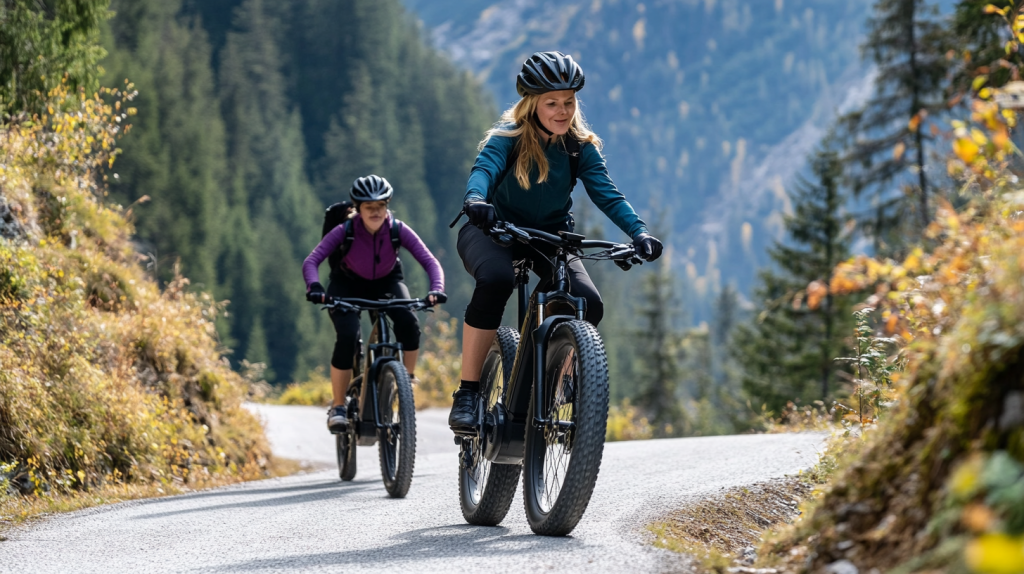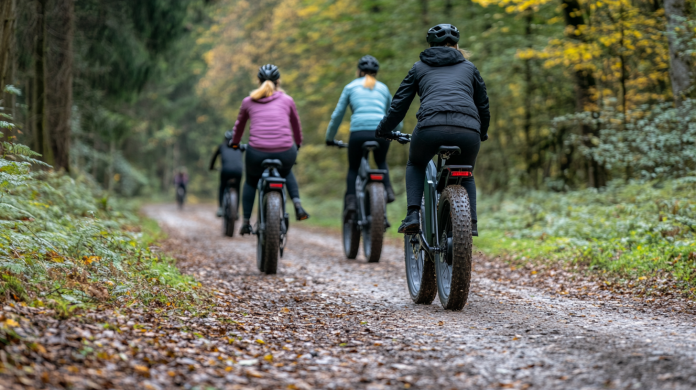In just one year, e-bike sales in the US hit $65 million. This shows how popular electric bikes are becoming on bike trails. They’re changing how we enjoy outdoor adventures and commute in a green way.
The Bureau of Land Management (BLM) has taken notice of this trend. In December 2020, they updated the rules to define e-bikes. Now, e-bike fans can ride in areas once only for off-highway vehicles (OHVs) on BLM lands.
Before you hop on an e-bike, know the e-bike laws in your area. Over 40 states have changed their e-bike rules in the last seven years. For example, Washington D.C. now lets most e-bikes on trails, making it easier for everyone to ride.
E-bikes are making cycling easier for more people. They help with hills and long distances without sweat. They’re also quieter and better for the planet than cars, fitting our move towards green transport.
Table of Contents
Key Takeaways
- E-bike sales in the US reached $65 million in a single year
- BLM amended regulations in 2020 to include e-bikes on public lands
- Over 40 states have updated e-bike laws in the past 7 years
- Washington D.C. now allows most e-bikes on off-street trails
- E-bikes enhance accessibility and promote sustainable commuting
Understanding E-Bikes: A New Era of Cycling
E-bikes have changed the way we cycle, mixing traditional pedaling with electric help. They’re making outdoor fun and daily trips easier for everyone.
What defines an e-bike?
Electric bicycles on trails have an electric motor and help you pedal. They come with a rechargeable battery that powers an electric motor. This lets riders go over tough paths and cover more ground with less effort.
The three-tier classification system
E-bikes are put into three groups based on their motor’s power and speed:
- Class 1: Pedal-assist up to 20 mph
- Class 2: Throttle-powered up to 20 mph
- Class 3: Pedal-assist up to 28 mph
This system helps manage the use of e-bikes on trails and keeps everyone safe.
Benefits of e-bikes for recreation and transportation
Pedal-assist bikes for nature trails bring many benefits:
- Let you ride further
- Help you over tough terrain
- Less need for cars for short trips
- Make outdoor activities easier
E-bikes let you enjoy cycling more while giving you a boost when you need it. This tech has opened new doors for outdoor lovers and commuters.
Electric Bikes on Bike Trails: Regulations and Access
E-bike trail rules change across the U.S., so riders must know the local laws. With e-bike sales jumping 95% in 2016-17, many states are updating their policies. This is to fit these new vehicles.
Federal Regulations for E-Bikes
The Consumer Product Safety Commission watches over e-bike making and first sale. E-bikes are put into three groups based on speed and how much help they give:
- Class I: Pedal-assist up to 20 mph
- Class II: Throttle-assist up to 20 mph
- Class III: Pedal-assist up to 28 mph
State-Level E-Bike Laws and Trail Access
31 states and Washington D.C. have their own e-bike laws. Colorado sees e-bikes as regular bikes unless proven otherwise. E-bike access on trails changes by state. Some let all types on trails, while others don’t.

Local Jurisdiction Policies on E-Bikes
Cities are starting pilot programs to see how e-bikes work on trails. In Boulder, Colorado, there were no bike crashes with e-bikes on trails. Park City, Utah lets e-bikes on paved trails but limits speed to 15 mph.
Boise, Idaho, and Tempe, Arizona now let Class I and II e-bikes on trails. When planning your ride, check the local rules and permits for e-bikes. Following trail etiquette for e-bikes is key for safety and fun for everyone.
E-Bike Technology and Components
E-bikes mix traditional cycling with electric power, changing trail experiences. At the core, they have a motor, battery, and controller. Each motor type offers special benefits for different riding styles.
Batteries, usually lithium-ion, power your ride. They’re made with safety in mind, having Battery Management Systems. With more e-bikes on the road, charging stations are becoming more common along trails.
Controllers let you change how much help you get, with options like eco, touring, sport, or turbo. This lets riders handle various terrains while keeping trails sustainable.
E-Bike Sales and Adoption
E-bike sales soared in 2022, reaching 738,454 units in the USA. What started with retirees has grown to attract people of all ages. They’re now the fastest-growing part of the bike world, beating electric cars.
E-Bike Classifications and Trail Use
PeopleForBikes created a three-class system for e-bikes, now in 40 states. Class 1 and 2 e-bikes can usually go on trails, following bike rules. This system keeps trails safe and fun for everyone.
| E-Bike Class | Motor Assistance | Max Speed | Throttle |
|---|---|---|---|
| Class 1 | Pedal-assist only | 20 mph | No |
| Class 2 | Pedal-assist and throttle | 20 mph | Yes |
| Class 3 | Pedal-assist only | 28 mph | No |
As e-bikes become more popular, taking care of trails is key. Regular maintenance keeps trails good for e-bikes for a long time. It balances new tech with caring for the environment.
Choosing the Right E-Bike for Trail Riding
Finding the perfect e-bike for trail riding can make your off-road adventures better. With more electric mountain bikes available, new technologies and drive systems keep coming up. Let’s look at the options to help you pick the right one.
E-mountain bikes for off-road adventures
Class 1 eMTBs are top choices for electric mountain biking trails. They don’t go faster than 20 mph and have a 750-watt limit. Mid-drive motors are better than hub motors for climbing.

- Bosch Performance CX: 75Nm torque, 4 power modes
- Brose: 90Nm torque, quietest operation
- Shimano STEPS MTB: 3 power modes, lowest torque
- Yamaha PW-X: 80Nm torque, 5 support modes
Commuter and leisure e-bikes for paved trails
For easier trails and gravel roads, pick e-bikes with 120mm fork suspension. Wheels of 29 or 27.5 inches work well for hills and gravel. Always follow e-bike trail etiquette on shared paths.
Considering battery range and motor power
Battery size is important for trail riding. Choose lithium-ion packs with at least 500 watt-hours. Some e-bikes even have two batteries for up to 1000Wh. Think about how far and high you ride to pick the right battery size.
Choosing the right e-bike is key to staying safe on the trails. Whether you’re into tough off-road e-biking or just enjoying the ride, there’s an e-bike for you.
Safety Considerations for E-Bike Trail Use
E-bikes are becoming more popular, making safety key. In 2023, the U.S. e-bike market hit $943.3 million and is expected to grow to $2.338 billion by 2032. This growth means more challenges for keeping trails safe.
Trail Etiquette for E-Bike Riders
E-bike riders need to follow trail rules for safety. Always yield to walkers and horses. Keep an eye on your speed, especially on paths shared with others. If you’re renting an e-bike, learn the local rules and use electric bike trail maps.
Speed Limits and Passing Guidelines
Many trails have a 15 mph speed limit. When passing others, slow down and leave at least 3 feet of space. Between 2017 and 2022, there were 53,100 e-bike injuries in the U.S. Following speed limits helps reduce risks.
| Year | E-bike Injuries | Market Share |
|---|---|---|
| 2016 | Data not available | 2% |
| 2023 | 24,335 | 18% |
Protective Gear and Visibility
Always wear a helmet and bright clothes to be seen. Use lights when it’s dark. The right gear and regular maintenance can lower injury risks.
Putting safety first and respecting trails for everyone makes e-biking rewarding and safe. Always know the local rules and trail conditions for a safe ride.
Environmental Impact of E-Bikes on Trails
E-bikes are changing the way we travel on trails in the USA. They’re selling fast – one e-bike is sold every 52 seconds in 2021. These bikes are making it easier to enjoy nature in a green way.
Studies show e-bikes make people cycle more and for longer times. They’re great for short trips, like commuting. In fact, 52% of U.S. trips are under 3 miles, perfect for e-bike rides. This could cut down car use and lower carbon emissions a lot.

E-bikes are good for the planet. They’re 93% better for the climate than cars. In Denver, e-bikes replaced 22 car miles per rider weekly. If Chicago did the same, it could save 6,700 metric tons of carbon emissions a year.
Worries about trail damage are not true. The International Mountain Bike Association found e-bikes and regular bikes have the same effect on trails. Both are as gentle as hikers. E-bikes on trails don’t wear them out more if riders follow the rules.
E-bikes are becoming a key part of sustainable travel on trails. By using them wisely, we can enjoy nature and protect our planet at the same time.
E-Bike Trail Accessibility and Inclusivity
E-bikes are changing the outdoor scene for everyone. They’re making trails open to more people. This change is bringing new fun and ways to get around.
Expanding outdoor recreation opportunities
E-bikes help many people enjoy trails they couldn’t before. In North Carolina, they’re allowed on all bike paths and sidewalks. This move is happening all over the country.
Adaptive e-bikes for riders with disabilities
Adaptive e-bikes are changing lives for riders with disabilities. They have three wheels for balance and are wider than regular bikes. They need trails at least 40 inches wide.
Trail builders are paying attention. They’re making paths wider and fixing tight spots for these bikes. This is key for making trails welcoming to everyone.
Age considerations for e-bike use on trails
Age rules for e-bikes vary by place. In Tempe, Arizona, you must be 16 or older to ride. Kids under 18 need helmets. Always check the local rules before you go.
| Location | E-Bike Class | Trail Access | Speed Limit |
|---|---|---|---|
| Oregon | All Classes | Allowed | 20 mph |
| Austria | 600W max | Allowed | 25 km/h |
| France | 250W max | Allowed | 25 km/h |
| British Columbia | Class 1 & 2 | Allowed | Varies |
Remember, following bike trail rules is important. Be respectful to others and know the local rules. With the right behavior, e-bikes can make trails fun for everyone.
Maintaining Your E-Bike for Trail Performance
Keeping your e-bike in top shape is key for safe and fun trail rides. Regular maintenance boosts performance and makes your e-bike last longer. Here are some important care tips for your e-bike.
Proper tire care is key, especially for off-road e-bikes. Always check your tire pressure before you ride and look for wear signs. Keep the pressure at the level the manufacturer suggests for the best trail performance.
Looking after your battery is crucial for e-bike maintenance. Extreme temperatures can hurt battery performance. Keep your e-bike in a cool, dry spot out of the sun. Always charge it with the charger from the maker to avoid damage.
After riding in the mud or rain, clean your e-bike well to stop rust and keep it running smoothly. Make sure to clean and check the motor often, as it’s a key part that needs regular care.
- Inspect brakes before each ride
- Lubricate the chain regularly
- Check and tighten all bolts monthly
- Service your e-bike every six months
Good bike maintenance helps with trail etiquette by making sure your e-bike is quiet and runs well. By following these tips, you’ll have safer rides and better performance on the trails.
| Maintenance Task | Frequency | Importance |
|---|---|---|
| Tire pressure check | Before each ride | High |
| Battery charging | After each ride | High |
| Cleaning | After muddy/rainy rides | Medium |
| Professional service | Every six months | High |
E-Bike Trail Etiquette and Best Practices
Electric mountain biking is getting more popular. It’s important to follow trail etiquette for a good experience. E-bike riders must respect the trails and others using them.
Respecting Other Trail Users
Always think about others when you’re on your e-bike. Slow down when you’re passing hikers or horses. Use a bell or say hello to let them know you’re coming. Many trails are used by different people, so be considerate.
Yield Protocols on Shared Paths
Knowing how to yield is key for safe e-bike use. Downhill riders should let others pass. If you meet pedestrians or horseback riders, get off your bike. This keeps everyone safe and happy on the trails.
Minimizing Environmental Impact
Rules for e-bikes help protect nature. Stick to the trails to avoid harming the environment. Don’t ride in wet conditions to keep the trails safe. These actions help make trails better for everyone.
“Preparation is key to safely navigating any trail. Carrying tools and supplies is essential,” says Robb Dorr, co-founder of PeopleForBikes, an organization advocating for bicycle access.
Local rules for e-bikes on trails can vary. Always check the rules in your area for a safe ride.
E-Bike Rentals and Guided Trail Experiences
E-bike rentals and guided trail experiences are becoming more popular in the USA. They let you explore new places while enjoying sustainable electric biking. Rental companies give you maps and safety tips for a great ride.
Pedego, a top e-bike brand, offers rentals and tours all over the world. You can find their services in places like Bethesda, Maryland, and La Jolla, California. Each spot has its own trails and experiences for different tastes and skills.
Popular E-Bike Tours
E-bike tours have many options. In Washington D.C., you can join a 3-4 hour tour of the National Mall and Monuments. Galveston, Texas, has scenic Seawall Tours. Norfolk, Virginia, offers Waterfront History Tours for history lovers.
For those who love wine, there are e-bike tours through vineyards. These tours need a group of at least 4 people and run on certain days and months. They also offer custom tours for big groups, families, and corporate events.
| Tour Type | Location | Duration |
|---|---|---|
| Monument Tour | Washington D.C. | 3-4 hours |
| Seawall Tour | Galveston, TX | 2-3 hours |
| Wine Tour | Hood River Valley | 4-5 hours |
When you rent, you usually get Class 1 ‘Pedal Assist’ e-bikes. Some places also have Burly ‘Bee’ Carts for families. Always check the trail rules for e-bikes before you go on your off-road electric cycling trip.
E-bike rentals and guided tours have received TripAdvisor’s Traveler’s Choice Award for three consecutive years, highlighting their growing popularity and quality of experience.
Conclusion
E-bikes have changed the way we cycle, offering fun and green rides for everyone. They come in three main types, fitting different needs from casual to adventurous riders. Class 1 e-bikes, with 750 watts and 20 mph help, are great for many trails, like those in Colorado Springs.
When looking into e-bikes, think about the battery life and how well they handle rough terrain. E-mountain bikes, or e-MTBs, are just 20 pounds heavier than regular bikes. This means you can go farther and ride more often. Plus, studies show they don’t harm the environment much, just like regular bikes.
Keeping riders safe is key when using e-bikes on trails. Even though e-bikes can go faster, especially uphill, following trail rules and design helps avoid problems. With e-bike sales jumping 190% in June 2020, it’s important to know the local rules and use trails responsibly. By doing so, you can enjoy e-bikes and keep trails open for everyone.




